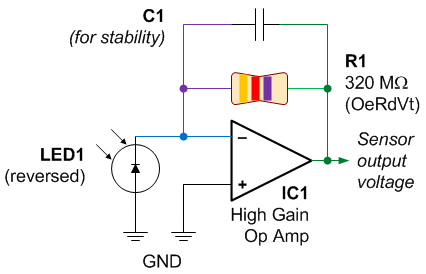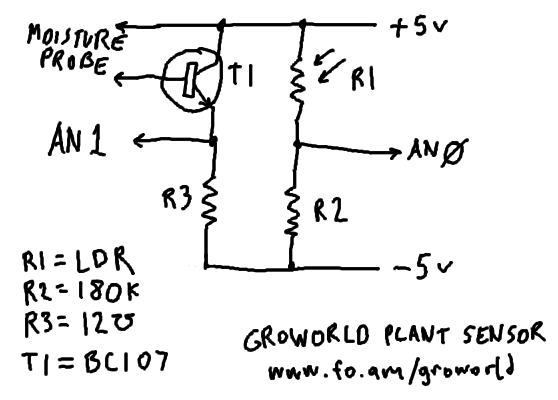
Color Sensor from a Reversed LED and Op Amp

One of the first lessons that electronics students learn is that an LED emits light when current flows through it. However, it is also true that when an LED is connected in reverse, it can generate a current flow when exposed to light. To demonstrate this, connect a high-quality ultra-bright red LED to a multimeter set to voltage measurement mode, and expose it to a light source such as a desk lamp. The multimeter will show a voltage reading. When the LED is placed in a dark area, the voltage will decrease. Photodiodes are commonly used in robotics and other devices as light sensors. These components are typically sensitive to a specific wavelength of light, often in the infrared spectrum. Interestingly, a reversed LED is most responsive to the same color of visible light that it normally emits. For instance, a reversed green LED will generate the most current when exposed to green light. Unfortunately, even under optimal conditions, both photodiodes and reversed LEDs do not produce significant current flow. To make the light-detection signal useful in most circuits, the output from the photodiode needs amplification. A photodiode that is amplified by an integrated transistor is referred to as a phototransistor. Although it is possible to connect a standalone photodiode to a single transistor, controlling the gain of a single-transistor amplifier can be challenging, and issues like signal noise and input current requirements may arise. A more effective approach for amplifying low-power signals in a consistent manner is to use an operational amplifier (op amp) chip. By combining these components, a color sensor can be created using a reversed LED and an op amp chip. This approach has been successfully implemented by TAOS with their TSLR257 (red), TSLG257 (green), and TSLB257 (blue) sensors. In this configuration, the LED (LED1) is oriented with the diode arrow pointing upwards, indicating that more light exposure results in increased current flow. The op amp (IC1) amplifies the weak signal from the reversed LED and outputs it through a designated pin. It is essential for IC1 to be an ultra-low input current op amp, as the reversed LED generates minimal current. Traditional op amps that require higher input current will not function effectively in this setup. Resistor R1 is included to allow a small portion of the op amp output to feedback into the input signal. Without R1, the high-gain op amp would amplify the LED1 signal excessively, causing it to saturate at 5V continuously. By providing feedback, R1 moderates the LED signal, ensuring that the op amp output voltage remains within a usable range between 0V and 5V. R1 can be thought of as a volume control; too high a resistance leads to oversaturation, while too low results in an output that is too weak to be effective. Capacitor C1 is included to stabilize the circuit, as it operates under conditions that can lead to oscillation due to low input signals, high resistance, and high gain. A small capacitance value, likely in the picofarad range, can help maintain signal stability. Similar circuit designs can be found in technical documentation from National Semiconductor and Texas Instruments regarding their op amps. While constructing a color sensor circuit using individual components will result in a larger footprint compared to integrated solutions, it offers the advantage of selecting specific wavelength sensitivity based on the chosen LED color, as well as the ability to adjust signal gain through the feedback resistance. The complete schematic and solderless breadboard layout for the reversed LED color sensor will be provided, along with a series of oscilloscope traces demonstrating the photodiode signal in operation. These traces will illustrate the effectiveness of various components in enhancing the circuit's performance.One of the first lessons that an electronics student learns is that an LED provides light from current flow. But, did you know that an LED put in backwards provides current flow from light Yes! It`s true. Hook up a high-quality ultra-bright red LED by itself (no battery or other circuitry) to a multimeter in voltage measurement mode.
Put the LEDagainst a light source, such as a desk lamp. See the voltage Now, hide the LED in a dark place. See a decrease in voltage Photodiodes are used in robots and devices as light sensors. Photodiodes have a spectrum wavelength to which they are most sensitive, usually infrared. But, not surprisingly, a reversed LED is most sensitive to the same color of visible light as it normally emits. For example, if a circuit uses a reversed green LED, the most current will flow from exposure to green light.
Unfortunately, even under the best conditions, photodiodes (and reversed LEDs) don`t provide a lot of current flow. The output of the photodiode needs to be amplified for the light-detection signal to be useful in most circuits.
A photodiode amplified by a built-in transistor is called a phototransistor. You can connect a standalone photodiode to the input of a standalone transistor. But, it isn`t easy to control the gain of a single-transistor amplifier, and there are issues with signal noise and the amount of input current required. Instead, a better method for amplifying low-power signals in a high-quality repeatable way is an op amp chip (operational amplifier).
Putting this all together - a color sensor can be made from a reversed LED and an op amp chip. In fact, TAOS did just that with their TSLR257 (red), TSLG257 (green), and TSLB257 (blue) sensors. LED1: Normally an LED has the diode arrow pointed down toward ground because conventional current flows that way. But, this reversed LED points up. The more light that hits it, the more current will flow. IC1: The op amp takes the weak signal of the reversed LED, amplifies it, and sends it out the output pin.
IC1 must be a ultra-low input current op amp. That means the chip can work with very little input current, which is good because the reversed LED can only produce a little current. This trick won`t work with an old-fashioned op amp, because it requires a lot more input current. Resistor R1 allows a teeny tiny bit of the op amp output to feed back into the input signal. If R1 didn`t exist, the high-gain op amp would amplify the LED1 signal so much that it would simply max out at 5V all the time.
But, by taking a bit of current and feeding it back, R1 reduces the LED signal just enough so that the op amp output voltage is a usable level somewhere between 0V and 5V. Think of R1 as the volume control. Crank the resistance too high and the output becomes too loud (oversaturated). Set the resistance too low and the output becomes too quiet to be useful. C1: Because this circuit deals with extremes (low input signal, high resistance, high gain), it may oscillate (change values back and forth) unintentionally.
Therefore, a small amount of capacitance (likely in the picofarad range) can stabilize the signal. However, this same type of circuit appears in white papers and technical notes for both National Semiconductor`s and Texas Instrument`s op amps. So, you can build a color sensor circuit using their parts. Although the circuit will be a lot larger than one integrated into a single component, you`ll be able to select specific wavelength sensitivity through your choice of LED color.
And, you`ll be able to determine the desired amount of signal gain through your choice of feedback resistance. On the next page you`ll see the complete schematic and solderless breadboard for the reversed LED color sensor.
The remainder of the article is devoted to a series of oscilloscope traces showing the photodiode signal in action. These trace tell the story of why certain parts in the circuit improve t 🔗 External reference
Put the LEDagainst a light source, such as a desk lamp. See the voltage Now, hide the LED in a dark place. See a decrease in voltage Photodiodes are used in robots and devices as light sensors. Photodiodes have a spectrum wavelength to which they are most sensitive, usually infrared. But, not surprisingly, a reversed LED is most sensitive to the same color of visible light as it normally emits. For example, if a circuit uses a reversed green LED, the most current will flow from exposure to green light.
Unfortunately, even under the best conditions, photodiodes (and reversed LEDs) don`t provide a lot of current flow. The output of the photodiode needs to be amplified for the light-detection signal to be useful in most circuits.
A photodiode amplified by a built-in transistor is called a phototransistor. You can connect a standalone photodiode to the input of a standalone transistor. But, it isn`t easy to control the gain of a single-transistor amplifier, and there are issues with signal noise and the amount of input current required. Instead, a better method for amplifying low-power signals in a high-quality repeatable way is an op amp chip (operational amplifier).
Putting this all together - a color sensor can be made from a reversed LED and an op amp chip. In fact, TAOS did just that with their TSLR257 (red), TSLG257 (green), and TSLB257 (blue) sensors. LED1: Normally an LED has the diode arrow pointed down toward ground because conventional current flows that way. But, this reversed LED points up. The more light that hits it, the more current will flow. IC1: The op amp takes the weak signal of the reversed LED, amplifies it, and sends it out the output pin.
IC1 must be a ultra-low input current op amp. That means the chip can work with very little input current, which is good because the reversed LED can only produce a little current. This trick won`t work with an old-fashioned op amp, because it requires a lot more input current. Resistor R1 allows a teeny tiny bit of the op amp output to feed back into the input signal. If R1 didn`t exist, the high-gain op amp would amplify the LED1 signal so much that it would simply max out at 5V all the time.
But, by taking a bit of current and feeding it back, R1 reduces the LED signal just enough so that the op amp output voltage is a usable level somewhere between 0V and 5V. Think of R1 as the volume control. Crank the resistance too high and the output becomes too loud (oversaturated). Set the resistance too low and the output becomes too quiet to be useful. C1: Because this circuit deals with extremes (low input signal, high resistance, high gain), it may oscillate (change values back and forth) unintentionally.
Therefore, a small amount of capacitance (likely in the picofarad range) can stabilize the signal. However, this same type of circuit appears in white papers and technical notes for both National Semiconductor`s and Texas Instrument`s op amps. So, you can build a color sensor circuit using their parts. Although the circuit will be a lot larger than one integrated into a single component, you`ll be able to select specific wavelength sensitivity through your choice of LED color.
And, you`ll be able to determine the desired amount of signal gain through your choice of feedback resistance. On the next page you`ll see the complete schematic and solderless breadboard for the reversed LED color sensor.
The remainder of the article is devoted to a series of oscilloscope traces showing the photodiode signal in action. These trace tell the story of why certain parts in the circuit improve t 🔗 External reference
Warning: include(partials/cookie-banner.php): Failed to open stream: Permission denied in /var/www/html/nextgr/view-circuit.php on line 713
Warning: include(): Failed opening 'partials/cookie-banner.php' for inclusion (include_path='.:/usr/share/php') in /var/www/html/nextgr/view-circuit.php on line 713





